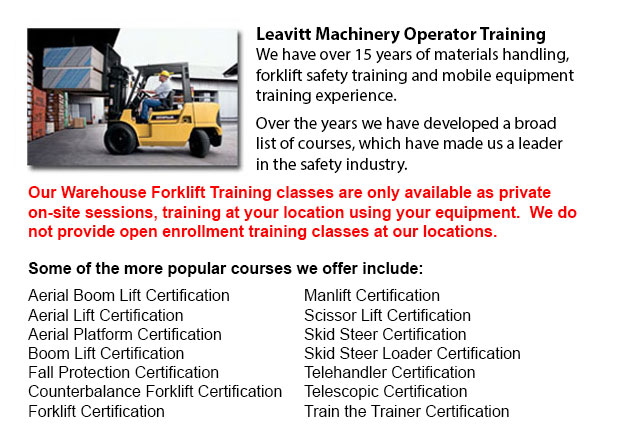
Warehouse Forklift Safety Training Langley - Companies usually face liability for damage and injuries sustained in workplace accidents. Warehouses can be hazardous places to the individuals who work there. That is the reason why employee safety is a top priority for many businesses. Warehouse safety training is one of the most effective measures to protect staff, while minimizing expenses associated with injuries and accidents.
The warehouse holds large amounts of materials and stock that can pose dangers, specially when these are being transported. The moving of stock making use of a powered machinery or manually could result in injuries the workers' hands, fingers, feet and toes. Slipping, tripping and falling are common reasons for injury. Heavy objects can fall off shelves and harm personnel. Forklifts and other machines carry inherent dangers as they manipulate heavily laden pallets. Improper lifting is a common source of back injuries. Even box cutters, nails and splinters can cause harm.
Depending upon the goods and materials which are being handled, the conditions of the warehouse can change from one minute to the next, especially with the machine being utilized and the work being done. Because of the wide variety of potential dangers in warehouse environment, warehouse operations are regulated by many various standards. There are rules for storage and material handling, for working and walking surfaces, and rules governing the selection and use of PPE (personal protective equipment).
Most of the safety regulations covered by a business would consist of common sense regulations. Regulations that warehouse employees should be quite familiar with consist of:
1. Safety is a top priority at all times when working in a warehouse.
2. PPE, such as gloves, safety shoes, eye protection and hard hats, must be worn as appropriate.
3. Inspect for hazards and report them or correct them.
4. Observe and Follow warning signs and signals.
5. Pay attention to the tasks you are doing.
6. Pay attention to the work which others are doing nearby, especially when they are working with forklifts and various dangerous machines.
7. Store and stack materials so that they're secure and stable.
Following good housekeeping rules would help to ensure a safe warehouse for all staff. Basic housekeeping regulations include keeping aisles and floors clear of things, like cords and wires. Never perch things insecurely on a surface. When spills occur, clean up at once. Dispose of trash in correct containers. Keep fire exits, fire extinguishers and sprinklers accessible. Put box cutters and various sharp tools away immediately after using. Report tripping hazards such as loose or damaged flooring.
-
Boom Lift Certification Langley
Boom Lift Certification Langley - Making use of elevated work platforms allow for maintenance operations and work to be performed at elevated work heights which were otherwise unreachable. Boom Lift Certification Training educates workers about safel... More -
Boom Lift Training Langley
Boom Lift Training Langley - Elevated work platforms, likewise referred to as aerial platforms, enable workers to carry out tasks at heights which would otherwise be unreachable. There are various types of lifts intended for various site applications... More -
Wheel and Track Loader Training in Langley
Lift trucks are available in a variety of various units that have varying load capacities. The majority of typical lift trucks used in warehouse settings have load capacities of 1-5 tons. Larger scale models are used for heavier loads, like loading s... More -
Counterbalance Forklift License Langley
Counterbalance Forklift License Langley - When operated by completely trained operators, forklifts could become a major advantage for firms and companies. We can offer your employees a thorough training program which consists of all factors of operat... More -
Aerial Lift Ticket Langley
Aerial Lift Ticket Langley - A boom truck is frequently recognized by the cable and telephone company vans that have the elongated arm folded over their roofs. Commonly, a bucket-like apparatus sits at the extension of extendable arms. Often termed a... More -
Aerial Lift Training Langley
Aerial Lift Training Langley - An aerial work platform is a mechanized access platform. This particular device provides access to otherwise not accessible places for equipment or people. Likewise known as an aerial device or elevating work platform,... More -
Wheel Loader Operator Training Langley
Wheel Loader Operator Training Langley - To be able to raise considerable weights, industrial cranes utilize pulleys and levers. In the past, Romans utilized cranes to construct huge monuments making the origin of these equipment at least two thousan... More -
Manlift Safety Training Langley
Manlift Safety Training Langley - It is important for competent Manlift operators to be aware of the connected dangers which come with particular kinds of scissor lifts. They must be able to operate the scissor lift in a way that protects not just th... More

Forklift Training Langley
TOLL FREE: 1-888-254-6157
Langley, British Columbia
forklifttraininglangley.com
Email Us
About Us


